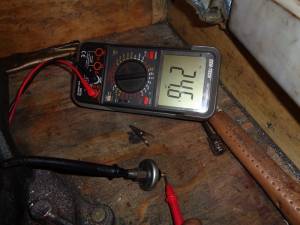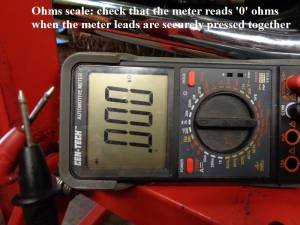Table of Contents
This is an old revision of the document!
REF: Tools - 159
Multimeter (VOM)
See also, Electrical Basics in the Sportsterpedia.
A multimeter or a multitester, also known as a VOM (volt-ohm-milliammeter), is an electronic measuring instrument that combines several measurement functions in one unit. 1)
A typical multimeter can measure voltage, current, and resistance.
Analog multimeters use a microammeter with a moving pointer to display readings.
Digital multimeters (DMM, DVOM) have a numeric display, and may also show a graphical bar representing the measured value.
Digital multimeters are now far more common due to their cost and precision, but analog multimeters are still preferable in some cases, for example when monitoring a rapidly varying value.
A multimeter can be a hand-held device useful for basic fault finding and field service work, or a bench instrument which can measure to a very high degree of accuracy. 2)
They can be used to troubleshoot electrical problems in a wide array of industrial and household devices such as electronic equipment, motor controls, domestic appliances, power supplies, and wiring systems.
Multimeters are available in a wide range of features and prices. 3)
Cheap multimeters can cost less than US$10, while laboratory-grade models with certified calibration can cost more than US$5,000.
Multimeters are extremely useful and are pretty hardy. 4)
But using the wrong setting, wrong scale, or performing the wrong type of measurement will at best give meaningless results, and at worst smoke the meter.
- Make sure the dial is on Ohms if checking resistance.
- DC Volts if checking voltage.
- Amps if checking current (usually also have to change the red test lead to the 10A terminal socket).
- Trying to read DC volts while the meter is in AC mode is pretty common (and frustrating).
- Putting the test leads across 12V with the leads in the amp range will most likely blow a fuse (or worse) which can cause unwanted delays while you fix/replace the meter.
- When reading resistance (ohms setting) you should short the leads together initially and read what the display says.
- Subtract this value if the meter cannot be zeroed.
(if the meter reads 0.2 ohms with the leads shorted, and 6.4 ohms across a winding, the true resistance will be 6.2 ohms).
- Make a good contact with the probes when trying to read the display.
- The values may move a little, but generally they will fluctuate around a meaningful value if the contact point is solid.
| See also Testing an oil pressure switch | When checking ohms, first check that the meter reads '0' ohms with leads pressed together. 5) |
 |  |
